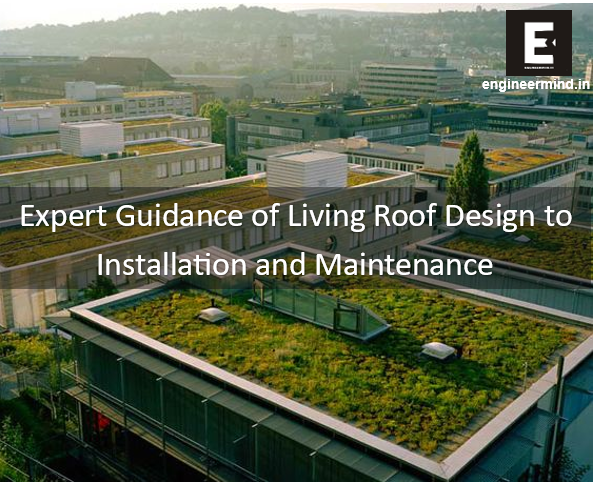Living roofs are an increasingly popular way to create a sustainable and aesthetically pleasing environment. Designing, installing, and maintaining a living roof correctly requires expert guidance. From the initial design process to the installation of the roof and its ongoing maintenance, it is important to have an experienced team on hand to ensure that your living roof is designed, installed, and maintained properly. This article will provide expert guidance on living roof design, installation, and maintenance.

Living roofs, or green roofs, have become increasingly popular. The benefits of living roofs are; reduced energy consumption, improved air quality, and mitigate the urban heat island effect. Living roofs are essentially a layer of vegetation planted on top of a building’s roof, creating a natural habitat for plants and wildlife. In this blog post, we’ll explore the world of living roofs, including the design factors to keep in mind, installation and maintenance tips, and examples of living roofs worldwide. Whether you’re considering installing a living roof or want to learn more about this sustainable building practice, we’ve got you covered.
Table of Contents
Design Factors to Keep in Mind for Living Roofs
A living roof’s design must consider climate, load-bearing capacity, drainage, and plant choices. The following are some essential factors for living roof design:
Climate
It is crucial to consider the climate of the area where the living roof will be built. The kinds of plants cultivated on a living roof will vary according to the local temperature and the quantity of wind, sunlight, and precipitation. For instance, the living roof in colder regions could need extra insulation to shield the plants from subfreezing temperatures.
Load-bearing capacity
Because living roofs are heavier than conventional roofing materials, a sturdy support structure is necessary to ensure their stability and safety. To ensure that the building’s structure can take the added weight of the living roof, it is crucial to assess the load-bearing capacity of the building before creating a living roof.
Drainage
A living roof cannot succeed without good drainage. Excess water can build up on the roof without proper drainage, causing damage to the plants and the roof and water infiltration into the structure. A system of drainage layers should be incorporated into the design of a living roof to effectively and efficiently drain any extra water from the roof.
Plant selection
A living roof’s ecology must be healthy and sustainable, so picking the correct plants for the job is crucial. The ability of plants to flourish in the particular climate, soil, and microclimate of the living roof should be considered when choosing plants. It’s critical to pick plants that require little irrigation and fertilization and don’t require much maintenance.
A successful and long-lasting living roof must be designed carefully, considering climate, load-bearing capability, drainage, and plant selection. Living roofs can offer a variety of environmental, financial, and social advantages to building owners and inhabitants by carefully choosing the correct plants and materials and creating an efficient drainage system.
Installation of Living Roofs
Installing a living roof can be difficult, requiring meticulous planning and execution before and during the installation. The following is a rundown of the standard procedures that are included in the installation process:
1. Preparation
To get ready, the first thing to be done is to inspect the current roof structure to see if it needs any adjustments or reinforcements. It is necessary to clean and level the surface of the roof and remove any debris that may be present.
2. waterproofing
The next phase in waterproofing involves installing a membrane that acts as a barrier between the building and any water that may try to penetrate it. This membrane is usually constructed out of PVC or synthetic rubber material.
3. Drainage and Insulation
After the waterproofing membrane has been laid down, a layer of drainage material is subsequently added on top of it. This layer prevents damage to the underlying structure by directing excess water away from the roof in which it is located. Insulation is another component to give thermal protection and stops heat from escaping the building.
4. Growing medium
At this point, a layer of growing medium is spread across the roof’s surface. The growth of plants can be supported by this medium, which also helps to keep moisture in the soil.
5. Plant selection and installation
The last phase selecting and installing the plants for the living roof is the plant installation and choosing. Plug planting, hydroseeding, and sodding are just a few of the many methods that can be utilized to establish seedlings in the growing media successfully.
Maintenance Tips For Living Roofs
A living roof must be properly maintained to ensure good health and viability. The following are some maintenance tips for living roofs:
Irrigation
Living roofs need consistent watering to maintain the plants’ health and ensure they continue to thrive. Irrigation systems may be built to ensure the plants receive an adequate water supply.
Pruning and weeding
It is essential to do routine pruning and weeding on a living roof to guarantee that the plants continue to thrive and look their best. This also helps to prevent the growth of undesired vegetation on the roof.
Fertilization
Applying fertilizer at regular intervals might assist in supplying the plants with the necessary nutrients and fostering healthy growth.
Inspection and repairs
It is essential to do routine inspections of the living roof to identify and address any problems, such as harmed plant material or leaks in the waterproofing membrane.
In general, the installation and maintenance of a living roof correctly are essential to the effectiveness and longevity of the system. Building owners and occupants can reap various environmental, economic, and social benefits by installing living roofs, but this requires careful design and execution.
Examples of living roofs around the world
There are many successful examples of living roofs around the world, showcasing the potential of this green technology. Here are a few case studies:
- California Academy of Sciences, San Francisco, USA: The living roof of the California Academy of Sciences in San Francisco is one of the largest and most complex in the world. It covers an area of 2.5 acres and features more than 1.7 million plants. The roof provides insulation, reduces energy consumption, and manages stormwater runoff.
- The Ford Dearborn Truck Plant, Michigan, USA: The Ford Dearborn Truck Plant has a 10.4-acre living roof installed to improve energy efficiency and reduce stormwater runoff. The top features over 700,000 plants and has helped the plant save over $50,000 annually in energy costs.
- Bosco Verticale, Milan, Italy: Bosco Verticale, or “Vertical Forest,” is a pair of Milan residential towers featuring over 900 trees and 20,000 plants. The living façade provides shade and insulation and improves air quality.
- The Royal Ontario Museum, Toronto, Canada: The Royal Ontario Museum has a 21,000-square-foot living roof that features over 20,000 plants. The roof provides insulation, reduces stormwater runoff, and provides a habitat for local wildlife.
- The Barbican, London, UK: The Barbican is a London residential complex with a large living roof. The roof provides insulation, reduces noise pollution, and improves air quality. It also features a variety of plant species, including wildflowers and sedum.
These are just a few examples of the many successful living roofs worldwide. Living roofs come in various shapes and sizes and can be designed to fit the specific needs of a building or site. With proper installation and maintenance, living roofs can provide multiple environmental, economic, and social benefits for building owners.
Conclusion
If you love gardening and want to enjoy the benefits of having a garden at home, then there is no better place than to have it on your roof. At first, having a garden on a rooftop may seem like a bad idea, but seeing the lush green grass and colourful plants that cover the house seems like a great idea.









